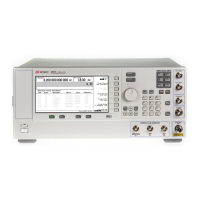E8257D/67D, E8663D PSG Signal Generators Service Guide
Troubleshooting
Troubleshooting Unlevels
1-67
Troubleshooting Unlevels
A leveled output power is obtained by comparing a detected voltage with a reference voltage. The reference voltage is
generated using DACs on the A10 ALC and the detected voltage is generated by coupling off a portion of the RF
output signal and converting it to dc using detector diodes. When the reference and detected levels are the same the
integrated output level remains constant. When the detected and reference levels are not the same, the integrator
output ramps either up or down to increase or decrease the detected level. If the integrator can not get the detected
voltage and the reference voltage to match, an unleveled annunciator is displayed.
The Automatic Leveling Circuit (ALC) uses two detectors and two modulator diodes. The A23 Lowband
Coupler/Detector is used for frequencies 2 GHz and below. The A25 Highband Coupler/Detector is used for all
frequencies above 2 GHz. The modulator in the A23 Lowband Coupler/Detector is used to control the RF amplitude for
frequencies 3.2 GHz and below. The modulator in the A30 Modulation Filter is used to control the amplitude for
frequencies above 3.2 GHz.
The RF path must provide a minimum power level to the ALC loop for the ALC loop to work properly. The minimum
power required is slightly higher than the maximum leveled power. The first step to troubleshooting a leveling problem
is to verify the RF path power level.
Troubleshoot and correct any unlock problems before troubleshooting unleveled problems.
If the unleveled annunciator is on:
1. Verify the signal generator’s amplitude is not set higher than the maximum level specified on the data sheet. Verify
that the signal generator’s RF output is terminated into 50 ohms. If the unleveled indication turns off after
resetting the amplitude or terminating the RF output into 50 ohms, the signal generator is operating correctly. If
the unleveled indicator remains on, proceed to step 2.
2. Using a spectrum analyzer check the RF signal level at the RF output connector.
a. Signal generator and spectrum analyzer setup:
Signal Generator:
•Turn ALC Off
• Set Amplitude to 30 dBm
• Turn Modulation Off
•Turn RF On
• Set Sweep to Frequency
• Set Sweep Type to Step (if Option 007 is installed, you can use ramp sweep)
• Set Start Frequency to 250 kHz
• Set Stop Frequency to 3.2 GHz
• Set Number of Points to 500 (skip this step if using ramp sweep)
Spectrum Analyzer:
• Set Start Frequency to 225 kHz
• Set Stop Frequency to 3.25 GHz
• Set Reference Level to +30 dBm
• Set Display to Max Hold
b. Connect the RF output of the signal generator to the spectrum analyzer. Measure and record the minimum
power level.
c. Set the signal generator and spectrum analyzer start/stop frequencies to the next start/stop frequencies in
Table 1- 16. Repeat step b above.
Table 1-16
Signal Generator Spectrum Analyzer
Start Stop Start Stop
3.2 GHz 20 GHz 3.15 GHz 20 GHz
20 GHz Max. Freq. 20 GHz Max. Freq.

